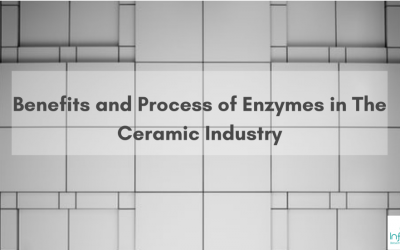Enzymes are known as protein catalysts which possess both reaction specificity as well as substrate specificity. They catalyze specific chemical reactions which include structural transfer, hydrolysis, elimination of specific functional groups, oxidation-reduction, bond formation, and isomerization, typically in the organic compounds.
The enzymatic reactions take place in living organisms naturally. However, in today’s times, enzymes are also used in bioreactors for manufacturing industrial products like medicines, drugs, agriculture chemicals, or components of detergents and toothpaste. Most of these enzyme-mediated chemical reactions are organic reactions, however, there also exist inorganic reactions involving enzymes.
The first attempt of enzyme-mediated ceramic synthesis dates back to 1961 wherein carbonate apatite was first synthesized with the help of mediation by a compound called carbonic anhydrase. In the following four decades, several scientists explored the process of enzyme-mediated ceramic synthesis and several unique products were discovered. However, this technique was not a part of the major area of ceramic science.
When a silicate synthesis enzyme called silicatein was discovered, it enabled the synthesis of silicon dioxide and titanium dioxide. This attracted attention to the several advantages of the synthesis of enzyme-mediated ceramics. The usage of enzymes in the ceramic industry and the process of ceramic synthesis, to be specific, has brought in several unique benefits like low-temperature ceramic synthesis, site-selective ceramic deposition, and an intact combination of ceramic materials with heat-sensitive materials. In a few cases, metastable crystalline phases have also been synthesized through the usage of enzymes.
Synthesis of ceramics mediated by enzymes stimulated the occurrence of a new stream of techniques for processing that use proteins or artificial peptide sequences which have the capability of precipitating ceramic materials out from the aqueous solutions.
Enzymes in the ceramic industry
Enzymes in the form of industrial biocatalysts provide numerous benefits over conventional chemical processes because of their process efficiency and sustainability. Enzyme catalysis has drastically scaled up for commercial purposes in several industries such as food and beverage, pharmaceutical, as well as ceramics. However, further enhancements when it comes to the biocatalyst functionality and stability are needed for optimum biocatalytic processes in the energy sector for natural gas conversion as well as biofuel production.
The technical barriers that are associated when implementing immobilized enzymes conclude that there is a need for a multidisciplinary approach for developing immobilized biocatalysts that are applicable in these industrial-scale processes.
Enzyme-mediated ceramic synthesis
The enzyme-mediated ceramic synthesis techniques generally fall into two different categories: Category I and Category II. Category I includes precipitants of the metal ions that are generated by the enzymatic reactions as well as the metal ions in the solutions getting precipitated into carbonates, oxides, phosphates, or hydroxides. Category II includes enzymes interacting directly with the metal-containing substrates for producing ceramic materials.
Applications of enzymes in the ceramic industry
Enzymes are proved to be highly efficient biocatalysts that are often researched for industrial-scale catalysts due to their many distinct benefits which range from their uses in milder reactions to their lower physiological and environmental toxicity and their exceptional product selectivity.
When it was found that enzymes can mediate the process of ceramic precipitation, it led to the development of a new technique of ceramic synthesis. This takes place under much milder conditions and allows control over morphology. However, this nature of enzyme-mediated ceramic precipitates when it comes to the crystalline phase, structural evolution as well as morphology when heated.
These enzyme-mediated ceramic precipitates are aggregates of several nanoparticles having a lower crystallinity and consist of larger amounts of hydration water. However, the kinds of ceramic precipitates are limited to the ones that can precipitate out of the aqueous solutions. These include carbonates, sulfides, hydroxides, hydrated oxides, metals, and phosphates that have been synthesized. Halides can also be precipitated, however, carbides and nitrides do not likely get synthesized unless the precipitates get subjected to the subsequent carbide formation or nitridation.
- The synthesis of enzyme-mediated ceramics enables us to make patterns and coatings.
- They also allow us for carrying out the fabrication of composites of ceramics with the help of heat-sensitive proteins or polymers.
- The enzyme-mediated hydroxyapatite-based biomaterials are being used in several animal tests and have provided successful results. One reason behind this could be that the enzyme-mediated hydroxyapatite is soluble easily in the body fluids because of its lower crystallinity. Also, releasing the calcium ions causes desirable effects like promotion of the differentiation of the osteoblastic cells.
- The enzyme-mediated hydroxyapatite-based biomaterials also serve as the initial example of several practical applications when it comes to this technique if there is a guarantee of biological safety of the enzymes as well as the reagents that are used.
- Additionally, the potential applications of this kind of technique consist of preparing the support for the immobilization of enzymes, nanoparticles for quantum dots, enzyme sensors, nanotubes, hollow ceramic microspheres, ceramic coatings, and ceramic patterns.
Our enzymes for the ceramic industry are designed and formulated specifically that work on a process wherein gelatin-specific and urea are inculcated. When you add our enzymes to suspensions, gelatin molecules get attracted to each either and form a 3D network with the help of hydrogen bonding because of the decomposition of urea. As a result, smooth surfaces, as well as a homogenous microstructure, are obtained.


